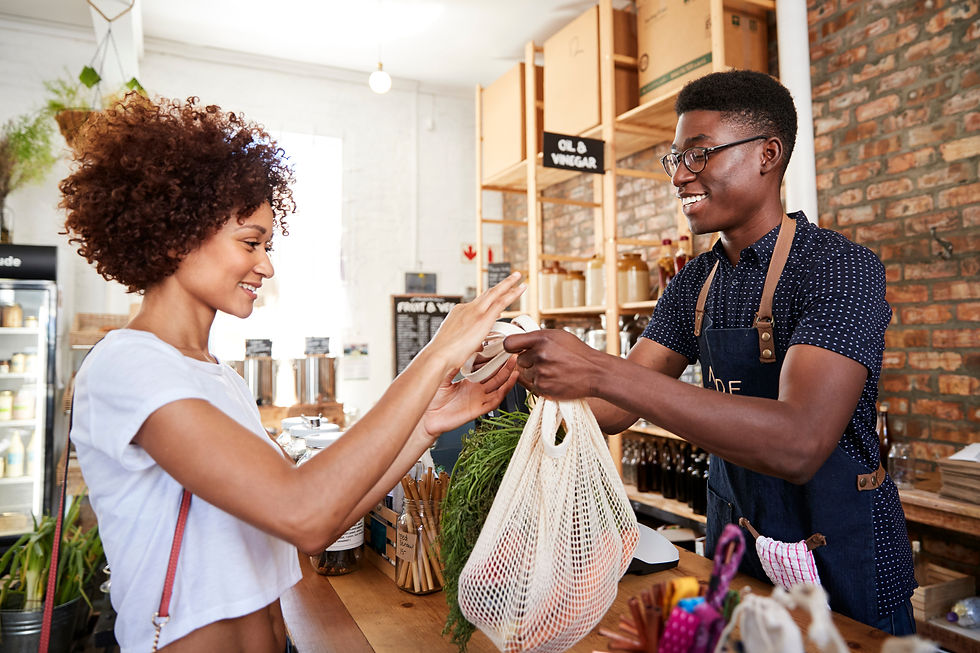Sustainable production; examining why SDG12 is important to SMEs
- Nov 26, 2021
- 3 min read
Updated: Sep 19, 2022

Over the past few weeks, we have talked about the Sustainable Development Goals, how they are the roadmap for companies of all sizes preparing for the future.
In this blog, we want to illustrate the difference embedding the SDGs can make and take a dive into how responsible consumption and production (SDG12) can positively impact the bottom line of any business while helping the global effort to reach 1.5°C.
Reaching Net-Zero
According to the Global Compact, over 1000 corporate organisations have pledged to reduce emissions to achieve the 1.5°C benchmark; part of that journey will be to reduce waste in the production process and encourage customers to consume less.
For example, in the fashion industry, we see an uptick in the promotion of vintage clothing. At the same time, the new right to repair rules in the U.K., though not perfect, are an essential step as products will have to be designed to be more repairable, helping consumers move away from the throwaway economy.
How do SMEs start their responsible consumption and production journey?

Understanding responsible consumption and production and why it is crucial to the bottom line are the starting points for any business.
Consumption and production are relevant to virtually every company from product development, supply chain management, end of life responsibility and even office practices.
Goods and services worldwide rely on the natural environment and plentiful resources, which has enabled economies and societies to flourish; however, there is a delicate balance between growth and social and environmental damage. According to the U.N., if the global population reaches the projected 9.6 billion by 2050, we could require three Earth's worth of resources to provide the necessary natural resources to sustain our current way of life.
What this means in real terms is that resources are already becoming scarce and that will accelerate. As well as the environmental damage, resources will also become more expensive, adding to the production costs for the business and consumption costs for the consumer. Combine this with new government regulations and changes in customer demand, businesses are exposing themselves to increasing risks.
To mitigate these business risks, businesses need to innovate and adapt, moving towards a more circular economy, away from the current linear model which promotes the take-make-waste mentality.
Ten ideas to help SMEs embed responsible production into their business and move towards a circular economy
Identify hot spots in your value and supply chain where a new process, innovation or design intervention could improve the environmental and social impact of the system as a whole.
Innovate products and services to comply with the principles of the circular economy, ensuring end of life recycle or reuse options exist for consumers.
Look at ways to minimise your carbon emissions at all stages of production; this ties to Climate Action, SDG 13 and hitting the 1.5 degrees target.
Use renewable energy in production and service facilities (SDG 7: Affordable and Clean Energy).
Eliminate waste from procurement to all stages of the supply chain. Ask your suppliers to reduce or remove the waste, and consider how the waste could be reused or upcycled.
Control and reduce any harmful emissions and pollutants (SDG 15: Life on Land).
Use environmentally safe chemicals, dyes, soaps and solutions (SDG 14: Life Below Water).
Use energy-efficient lighting.
Ensure all supplies are sustainably sourced and certified.
Consider how you could raise employee awareness, helping them make positive changes at work and home, such as identifying food waste and reducing it.
How can responsible production and consumption support a social enterprise?

One of our long-standing clients, AfriReuse, is a social enterprise based in western Kenya. Their purpose is to relieve period poverty in Africa by creating reusable fabric period packs. Their products can last up to four years, making them incredibly cost-effective while producing less waste as well as being much more affordable than disposable pads.
AfriReuse's core business model incorporates responsible production while also promoting responsible consumption. Through our work with the AfriReuse team, we have also shown them how SDGs 3 (Good Health and Wellbeing), 5 (Gender Equality), and 10 (Reduced Inequalities) can also be embedded into their business activities.
By incorporating these positive communication points into their product promotion, AfriReuse is steadily growing its market, meeting consumer needs, increasing sales and reducing costs.
Transitioning to a sustainable business model is not only good for the environment and the communities we live in, but it is also good for the bottom line of an organisation, whether that is an SME, social enterprise or a larger corporate.
Contact us
In this decade of action, knowing where to start on your sustainability journey can be a challenge. But we firmly believe that businesses of all sizes can make the journey.
To learn more about SDG Changemakers and how we support organisations to embed sustainable consumption and production into their business operations - get in touch.


Comments